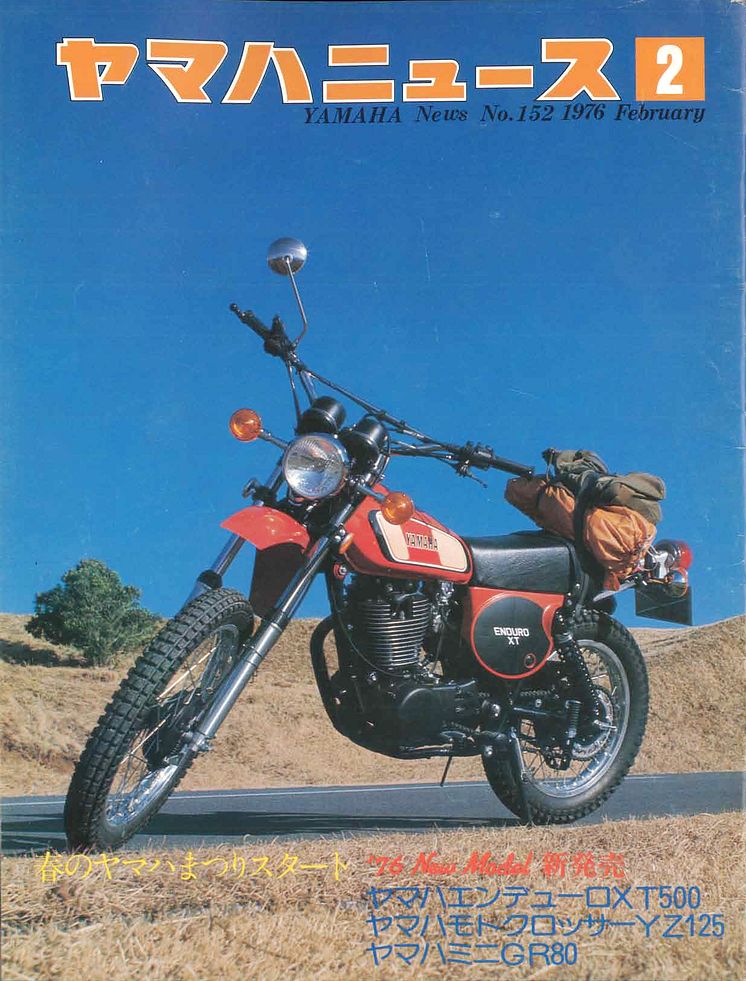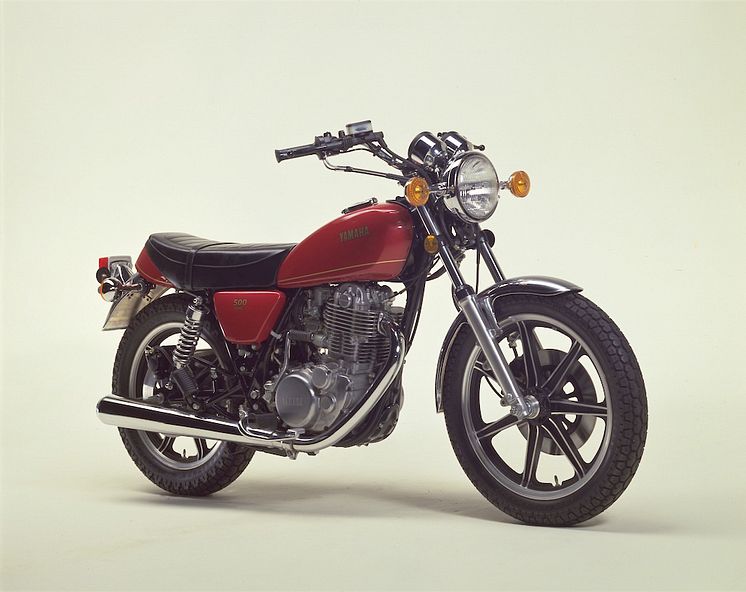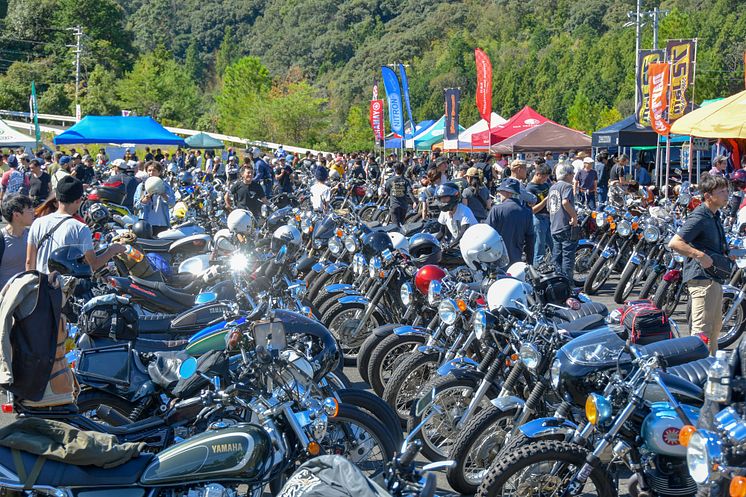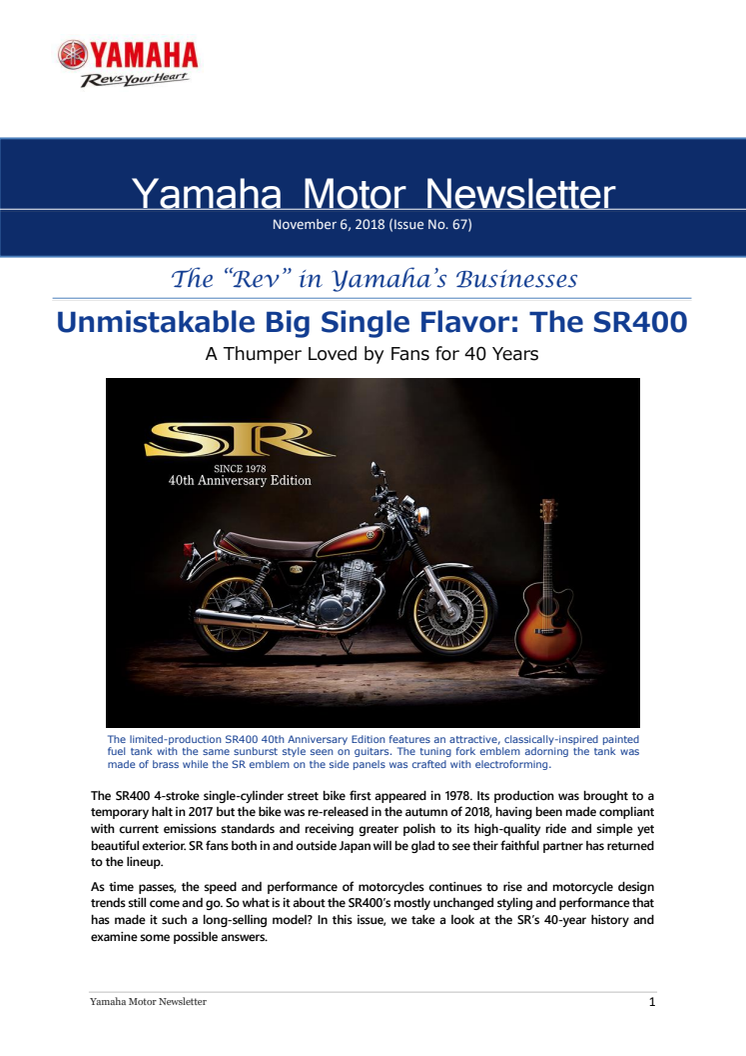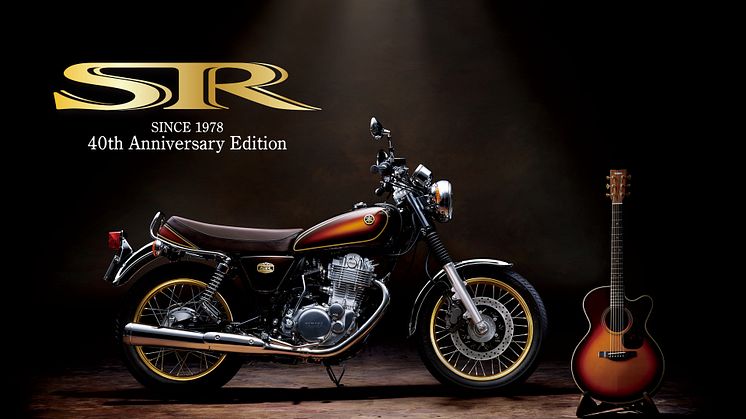
News -
Unmistakable Big Single Flavor: The SR400 Yamaha Motor Newsletter (November 6, 2018 No. 67)
The SR400 4-stroke single-cylinder street bike first appeared in 1978. Its production was brought to a temporary halt in 2017 but the bike was re-released in the autumn of 2018, having been made compliant with current emissions standards and receiving greater polish to its high-quality ride and simple yet beautiful exterior. SR fans both in and outside Japan will be glad to see their faithful partner has returned to the lineup.
As time passes, the speed and performance of motorcycles continues to rise and motorcycle design trends still come and go. So what is it about the SR400’s mostly unchanged styling and performance that has made it such a long-selling model? In this issue, we take a look at the SR’s 40-year history and examine some possible answers.
The Unique Style of Yamaha: Its Own Value and Monozukuri for the Senses
What is the value and charm of a motorcycle? Ever since its founding, Yamaha Motor has always been searching for the answer and proposing some of its own. In Japan during its post-war recovery, most motorcycles were designed to be easy to ride, practical and convenient, so Yamaha made a statement in 1955 by focusing on pride of ownership instead with the YA-1—nicknamed the Akatombo (Red Dragonfly)—with its beautiful exterior, high-quality construction and agile ride. Following that was the YDS-1 in 1959, a genuine sport bike that was equally capable in racing. Then, the DT-1 in 1968 had a slim, lightweight chassis derived from motocross racebikes, a long-stroke suspension and a torquey engine that gave it fantastic off-road performance. All of these were groundbreaking models and catalysts in kicking off new motorcycling trends in their respective eras.
From the late 1960s and into the 1970s when Japan’s highway system was being built and put into operation, several of Yamaha’s competitors began developing large-displacement, multi-cylinder, high-powered “superbikes” with an eye on the United States, the world’s largest motorcycle market at the time. Yet Yamaha still put priority on producing lightweight, slim and easy-to-use machines, eventually adding the XS-1 (1970) and other 4-stroke in-line 2-cylinder sport bikes to the lineup.
In the years that followed, Yamaha introduced the unique GX750 (XS750) 3-cylinder sport bike, the powerful XS1100 4-cylinder tourer for overseas markets, the XS650 Special and XS750 Special hailed as the first full-fledged Japanese cruisers, as well as several 250cc and 400cc 4-stroke models. Yamaha released this wide array of models one after another to meet diversifying user needs, but focused on high quality and performance only as a base; motorcycles still had to prioritize the appeal to people’s senses to be “complete,” and this was put forth as “a new era of Yamaha sport bikes” in 1978.
The SR400 is another Yamaha product that was born from this approach. It was developed based on the wildly popular XT500, a 4-stroke “big single” (high-displacement, single-cylinder) off-road model released in markets like the United States, Europe and Japan slightly earlier in 1976. The SR400 was a road-going sport model with a pulsating, torquey ride as its primary appeal.

The XT500 adorned this 1976 issue of the Yamaha News newsletter aimed at Japanese motorcycle dealerships. At the time, the XT500 was the largest big single in Japan, and the dual-purpose machine provided exhilarating riding fun both on and off the road.
Uniquely SR: Single, Slim and Simple
Inspired by European scrambler models of the time, the XT500 was planned and developed to be a machine capable of powering through challenging terrain like North American deserts and wilderness. Its SOHC single-cylinder engine was engineered to be light and durable, and the bike became a highly popular choice for weekend recreation. It saw plenty of racing action as well, taking successive victories in the 1979 and 1980 Paris-Dakar Rally.
The XT500’s engine was re-purposed for use on the road by making it rev higher, and completely revamping the intake and exhaust systems. In addition to that, CDI ignition, a decompressor, a vacuum petcock and other new parts were added to make the machine easier to handle and more enjoyable to ride. This updated machine became the SR500, while the smaller SR400 was released in Japan to fit the country’s tiered motorcycle licensing system.
“The chassis was designed to be closer to the dirt track racers popular in America than a road-going sport bike,” says the leader of the SR development project at the time.

The original SR500 for the North American market had a rear disc brake not seen in other regions, as well as the latest cast-aluminum wheels before most other models of the time, aligning it well for the demands of its intended market.
Various parts of the chassis were revised and reinforced, including a tougher frame to withstand the strong torque of the engine, a teardrop fuel tank, flat seat, and a suspension setup that featured spoked wheels and a front disc brake, all of which combined to give the SR its signature simple and slim silhouette.
Furthermore, painstaking craftsmanship went into the SR’s exterior appearance, like the engine crankcase’s buffed finish that accentuated the material qualities of aluminum, while the exhaust pipe, fenders and instrument dial casings were chromed. This made the SR strongly appeal to people who were less interested in outright power and speed, and more in the character of the ride and the sense of ownership, or as a base for customization.
Following that, the SR has seen minor changes to fit the times, such as suspension adjustments, new color schemes or parts to help it clear environmental and safety regulations. This allowed its engine specs and styling to remain the same since its debut. As the SR matured over the course of ten and then twenty years, there were times when sales were slow and it looked as if production of the bike would cease. But the many voices of fans inside and outside Yamaha, as well as those involved in its production and sales, praised the SR, lauding its orthodox style and simple single-cylinder engine, noting that there has been no other motorcycle to last as long and attract fans the way it has with such a unique presence. They saw it as one of Yamaha’s most valuable assets. With the support of these fans, the SR managed to overcome every dilemma it faced.
However, in 2000, the effects of emissions regulations did indeed bring a halt to the production of the SR500. And then in 2017, the SR400 met the same fate. But that was only a temporary measure, as the SR400 returned to its fans one year later as if nothing had happened, restating the original and universal appeal of motorcycles to the market.

SR500 and SR400 models from throughout the years were packed in at an SR owners event in Japan.
The Future: Unchanging Form and Quality
Introducing a new SR400 four decades after its debut did not mean introducing a similar model bearing the SR name or a totally different model altogether, but rather bringing back the same beloved SR form and performance with new technologies so that it can still be produced five or ten years from now.
Although this may seem trivial at first, it is actually anything but. For example, to clear emissions regulations, the engine control unit had to be enlarged and a canister added to the fuel tank to reduce gasoline evaporation. It was a challenge to find locations for these parts and devise methods to install them without affecting the look of the bike. Another example was meeting the new regulations for headlight lenses. Using plastic constituted an easy and more cost-effective solution, but the team prioritized quality and insisted on clearing the regulation by crafting a headlight with glass.
Manufacturing processes and techniques must be updated and professional craftsmen trained in order to continue producing items rarely seen on motorcycles nowadays, such as chrome-plated steel fenders and mufflers, exhaust pipes with smooth and beautiful curves, or masterfully sunburst-finished fuel tanks. Ongoing efforts like these are what have kept the SR authentic for so many years and will continue to do so going forward.
Such endeavors are deemed unnecessary if costs and work efficiency are given priority and there are often numerous alternatives. However, Yamaha saw the value in going that far with the SR. That is why the decision was made to bring it back, and the SR400 will continue to write the next chapters of the SR’s decades-long story.
The SR400 – Inheriting the Yamaha Spirit
This video (in Japanese only) features the engineers involved in the
returning SR400’s planning, development and design.
|
Message from the Editor |
|
The SR400 is without a doubt one of Yamaha’s most representative motorcycles. Even if you look around the world, I think it’s pretty rare for any industrial product to have gone for 40 years without any major change to its design or styling. While I was in overseas marketing, I was in charge of introducing the SR400 to the Thai market and planned a meeting for SR owners in Bangkok and Chiang Mai. I thought the SR wasn’t that well known outside of Japan, but the event was a resounding success and I remember being left surprised at the number of SR owners that showed up and wondering how there could be so many. I hope owners everywhere continue to treasure and ride these iconic machines for years to come. |
|
Naoto Horie |


